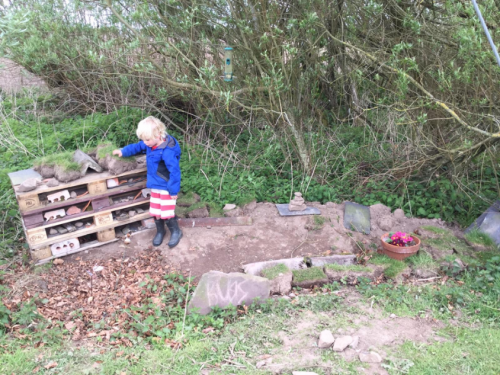By building your own ‘bug hotel’ (otherwise known as a wildlife hotel) you could provide shelter for garden visitors such as hedgehogs, bees, ladybirds, lacewings, ground beetles and lots more garden creatures.
Let’s get started: now what could you use to construct your hotel? We would suggest a mix of some of the following:
Old wooden pallets, strips of wood, logs, straw, moss, dry leaves, woodchips, bark, cones, old ceramic pots, old roofing tiles, old bricks (preferably with holes), empty snail shells, sand, soil, hollow bamboo canes, dead hollow stems cut from shrubs, roofing felt, planks of wood with drilled holes….and whatever else you can find in the garden, preferably made of natural materials. Ideally you want to use wood that has not been treated with chemicals such as paint or varnish, as this can repel insects and please do not use plastic tubes.
You can build your bug hotel at any time of the year, but what better time than the spring/summer time when lots of creatures are exploring your garden.
Here is a suggested plan for your construction:
- Choose a suitable plot:
First consult an adult to make sure they are happy with the location of your bug hotel and make sure any builds are not too big or unstable that they might fall down and hurt someone – SAFETY FIRST.
If you have vegetable beds, keep the bug hotel away from them too – you don’t want them to eat your dinner before you can!
You will get different bug residents depending on where you build your hotel, as some visitors like cool, damp conditions (such as toads) while others (such as bees) prefer a sunny position. For bees, you want your hotel to be at least a metre off the ground. Bees will use your construction as a nursery for their developing larvae.
- Build the main structure:
You will need a strong, stable framework that is no more than a metre high. Old wooden pallets are great as they are strong and come with ready-made spaces. Begin by laying some bricks on the ground as corners. Leave some spaces in between the bricks. Add three or four layers of wooden pallets on top of your bricks. If you leave larger gaps at the ends, you are more likely to attract hedgehogs.
- Fill in the spaces in your main structure:
The plan is to provide all sorts of different nooks and crannies, tunnels and cosy beds for your visitors. Dead wood, bark, moss, cardboard tubes and logs are good materials to use to provide a variety of habitats for your visitors. Tiles and soil help to create places for frogs to live and dry leaves and straw will attract ladybirds. You could also consider placing a hedgehog box at the base of the hotel if you have one.
- Put the roof on:
When you think your bug hotel is tall enough (and remember to make sure that it is stable) then place a roof on to keep it relatively dry. Use old planks of wood covered with roofing felt if you can find some. Old tiles and slates can also be used. You can place gritty soil on top and even make a grass roof. Maybe over time some wildflower seeds could get blown in there too and you will be able to watch them grow and attract the insects. Wildflowers can help our well-being as well as the environment.
- The bug hotel playpark and water park:
Plant some nectar-rich flowers around your bug hotel – these are important food for butterflies, bees and other pollinating insects. A shallow dish of water, filled with stones, for bees to drink from can be added near the hotel or on top of it.
- Open your bug hotel:
Put a sign outside your bug hotel and name it something interesting such as SEFARI Hotel, Grub Gateway, Beetle Box, Hugh’s hotel (that’s the name chosen for the example in the photo).
- Enjoy watching visitors come and go in your bug hotel and take photos:
If you go out at night with a torch you will hopefully catch sight of the many visitors to your bug hotel in the months to come. You can see how your visitors change with the seasons and weather conditions and enjoy becoming a bug detective too! Then you can send a photo to us at info@sefari.scot or tag us in a tweet @SEFARIscot, we’d love to see your hotels and the wildlife who visit too.
- Finally, do your housekeeping:
It is also important to remember to spring clean your bug hotel (or rather late summer cleaning) which should be done every 1-2 years to prevent the build-up of mites, mould and other things that could be detrimental to the hotel’s inhabitants. Remove any dead insects, mouldy items and sawdust. Then continue to enjoy the many fascinating creatures that will visit your hotel.
Professor Lorna Dawson (@Soilfit) and Dr Jenni Stockan (@JenniStockan).
Note: SEFARI has recently started to collate a variety of additional, free to access, educational resources which can be found here. In addition, there are some activities around soil and crofting available on our site too.
